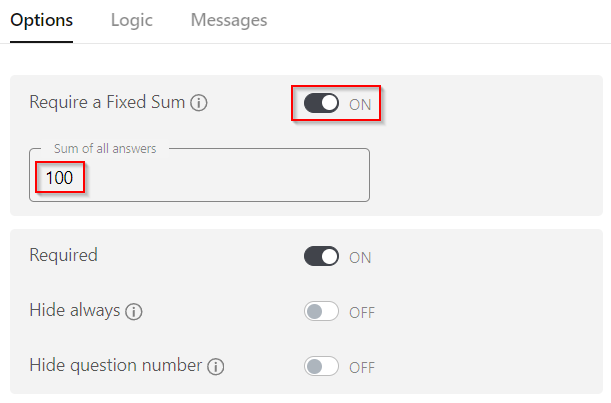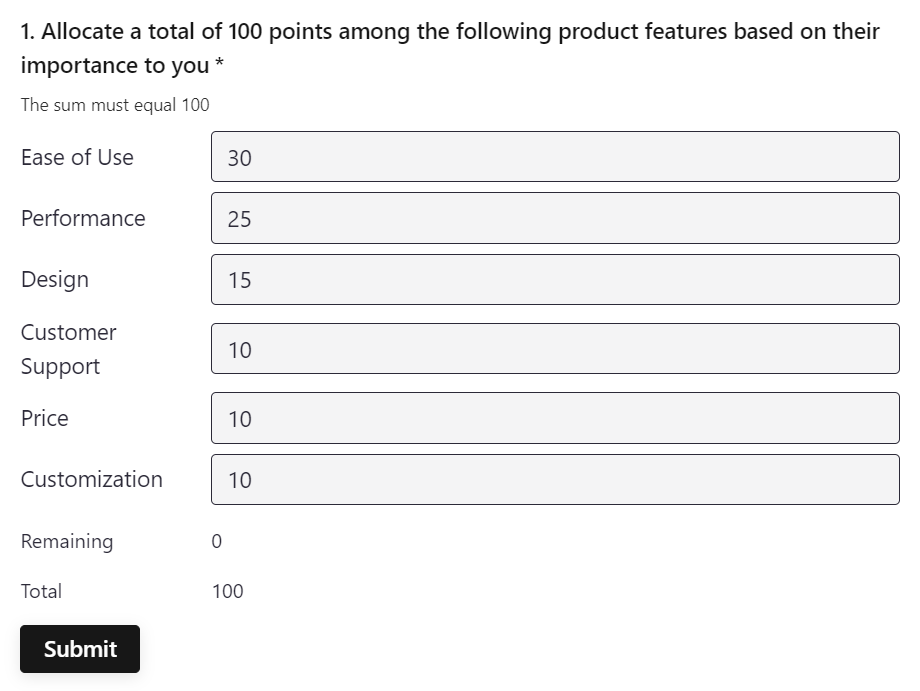Get insights.
Unlock value.
- 14-day free trial
- Set up in minutes
- No credit card required
How to use constant sum in surveys?
Ever felt like your survey respondents say they love everything? Traditional rating scales might not reveal the whole story. Imagine you're a product manager trying to understand which features of your product your users value the most. Simply asking them to rate each feature might not give you the complete picture, as they might rate everything highly without showing clear preferences. This is where Constant Sum questions come to the rescue.
Constant Sum is a type of question where respondents are given a fixed number of points to allocate among various options. This method requires them to distribute these points according to their preferences or priorities, providing a clearer picture of what truly matters to them. By allowing respondents to distribute a fixed number of points among various options, you can gain deeper insights into their true priorities. This method not only reveals the relative importance of each feature but also provides a comparative analysis that can drive more informed decision-making.
What are the Advantages of Using Constant Sum Questions in Surveys?
Constant sum questions, known as Multiple Numberboxes questions in BlockSurvey, offer several advantages in surveys:
- Detailed Insights: Constant sum questions provide more granular data by revealing the relative importance or preference for each option. This helps in understanding the prioritization among different factors.
- Prioritization: Constant sum questions help in understanding the trade-offs respondents are willing to make. This is particularly useful in market research, where understanding consumer priorities is crucial.
- Quantitative Data: The numerical data obtained from constant-sum questions can be easily analyzed statistically, providing clear and actionable insights.
- Allocation of Resources: In organizational surveys, they can be used to allocate resources or budgets based on employee or customer preferences, helping in effective decision-making.
- Avoids Extreme Bias: By forcing respondents to distribute a fixed amount, it prevents the tendency to rate all items highly or poorly, thus reducing extreme bias and providing a more balanced view.
How to Set Up Constant Sum in BlockSurvey?
Step 1
Add the Multiple Numberboxes question (aka Constant Sum) to your survey.
Step 2
On the survey screen by default, the input numbers will automatically sum up and display the total.

Step 3
Require a Fixed Sum: To ensure that respondents’ inputs meet a predefined total, enable the "Require a Fixed Sum" toggle under the Options tab and specify the total sum required.

Step 4
On the survey screen, respondents will enter their inputs, ensuring the total matches the given fixed sum.

Use Cases of Constant Sum
Here are some uses of constant sum questions in a survey:
- Preference Measurement: A company wants to know which product features are most important to its customers. Respondents could be given 100 points to distribute among different features like price, quality, brand, and service.
- Resource Allocation: A business is seeking feedback on how to allocate its budget across different departments. Employees might be asked to distribute a fixed sum of money across departments like marketing, R&D, and operations.
- Importance Ranking: In a customer satisfaction survey, respondents could distribute points across various aspects such as product performance, customer service, and price to indicate their importance in overall satisfaction.
- Trade-off Analysis: To understand trade-offs customers are willing to make, a company might ask how they would allocate points between cost and quality for a new product.
- Market Research: To gauge market demand, respondents might distribute points among different product categories or brands, revealing which are seen as most valuable.
- Employee Feedback: In an employee engagement survey, employees could allocate points to different factors such as work-life balance, salary, and career growth opportunities to show which ones matter most to them.
- Feature Prioritization: When developing a new software product, a company might ask users to allocate points to different potential features to determine which should be prioritized in development.
Conclusion
Constant Sum questions offer a unique way to delve deeper into respondents' preferences and priorities. By setting up this question type in BlockSurvey, you can leverage detailed insights, comparative analysis, and prioritization to make more informed decisions. Try out this feature in BlockSurvey to enhance your survey’s effectiveness and uncover what truly matters to your audience.
How to use constant sum in surveys? FAQ
What is a Constant Sum question?
A Constant Sum question asks respondents to distribute a fixed number of points across multiple options, revealing their relative preferences or priorities rather than absolute ratings.
How is a Constant Sum question different from a regular rating scale?
Unlike rating scales, which allow respondents to rate everything highly, Constant Sum forces prioritization by limiting the total points, helping you uncover what matters most to each participant.
What are the benefits of using Constant Sum questions?
They provide detailed, comparative insights, avoid extreme rating bias, support quantitative analysis, and are ideal for trade-off scenarios and resource prioritization.
What happens if the sum doesn’t match the required total?
BlockSurvey’s interface prompts the respondent to adjust their inputs until the total matches the required sum before they can proceed—ensuring data accuracy.
Get insights.
Unlock value.
- 14-day free trial
- Set up in minutes
- No credit card required





